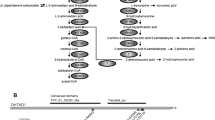Summary
We studied two unrelated male probands with mild ornithine transcarbamylase (OTC) (E.G.2.1.3.3) deficiency presenting a similar clinical course. Previous analyses of their liver OTCs also revealed similar properties. To identify the underlying molecular defects, we first cloned the entire coding region of the OTC gene from one proband and found a single base-substitution (C to T) leading to the substitution of tryptophan for arginine at amino acid position 277. Using a genomic amplification technique followed by allele specific oligonucleotide hybridization, we identified the same point mutation in the OTC gene of the other proband. We observed the presence of the mutation among family members in at least three generations, and in one asymptomatic hemizygous sibling in each family.
Similar content being viewed by others
References
Adachi T, Tanimura A, Asahina M (1963) A colorimetric determination of orotic acid. J Vitaminol 9:217–226
Briand P, Francois B, Rabier D, Cathelineau L (1982) Ornithine transcarbamylase deficiencies in human males; kinetic and immunochemical classification. Biochem Biophys Acta 704:100–106
Brusilow SW, Horwich AL (1989) Urea cycle enzymes. In: Scriber CR, Beaudet AL, Sly WS, Valle D (eds) The metabolic basis of inherited disease, 6th edn. McGraw-Hill, New York, pp 629–663
Brusilow S, Valle D (1987) Allopurinol (AP) induced orotidinuria (ODNU): a test of heterozygosity for ornithine transcarbamylase (OTC) deficiency. Pediatr Res 21:289A
Chou PY, Fasman GD (1978) Prediction of secondary structure of proteins from their amino acid sequence. Adv Enzymol 47:45–148
Finkelstein JE, Francomano CA, Brusilow SW, Traystman MD (1990) Use of denaturing gradient gel electrophoresis for detection of mutation and prospective diagnosis in late onset ornithine transcarbamylase deficiency. Genomics 7:167–172
Grompe M, Muzny DM, Caskey CT (1989) Scanning detection of mutations in human ornithine transcarbamylase by chemical mismatch cleavage. Proc Natl Acad Sci USA 86:5888–5892
Hata A, Tsuzuki T, Shimada K, Takiguchi M, Mori M, Matsuda I (1986) Isolation and characterization of the human ornithine transcarbamylase gene: structure of the 5′-end region. J Biochem 100:717–725
Hata A, Tsuzuki T, Shimada K, Takiguchi M, Mori M, Matsuda I (1988a) Structure of the human ornithine transcarbamylase gene. J Biochem 103:302–308
Hata A, Tsuzuki T, Shimada K, Takiguchi M, Mori M, Matsuda I (1988b) Structural organization of the human ornithine transcarbamylase gene. J Inherited Metab Dis 11:337–340
Hata A, Setoyama C, Shimada K, Takeda E, Kuroda Y, Akaboshi I, Matsuda I (1989) Ornithine transcarbamylase deficiency resulting from a C-to-T substitution in exon 5 of the ornithine transcarbamylase gene. Am J Hum Genet 45:123–127
Huygen R, Crabeel M, Glansdorff N (1987) Nucleotide sequence of the ARG3 gene of the yeastSaccharomyces cerevisiae encoding ornithine carbamoyltransferase. Comparison with other carbamoyltransferases. Eur J Biochem 166:371–377
Maddalena A, Sosnoski DM, Berry GT, Nussbaum RL (1988a) Mosaicism for an intragenic deletion in a boy with mild ornithine transcarbamylase deficiency. N Engl J Med 319:999–1003
Maddalena A, Spence JE, O'Brien WE, Nussbaum RL (1988b) Characterization of point mutations in the same arginine codon in three unrelated patients with ornithine transcarbamylase deficiency. J Clin Invest 82:1353–1358
Matsuda I, Nagata N, Oyanagi K, Tsuchiyama A, Yamamoto H, Hase Y, Kodama H, Kai H (1984) Biochemical heterogeneity of ornithine carbamyl transferase (OTC) in patients with OTC deficiency. Jpn J Hum Genet 29:327–333
Matsuda I, Nagata N, Matsuura T, Oyanagi K, Tada K, Narisawa K, Kitagawa T, Sakiyama T, Yamashita F, Yoshino M (1991) Retrospective survey of urea cycle disorders. I. Clinical and laboratory observations of thirty-two Japanese male patients with ornithine transcarbamylase (OTC) deficiency. Am J Med Genet 38:85–89
McClead RE Jr, Rozen R, Fox J, Rosenberg L, Menke J, Bickers R, Morrow G III (1986) Clinical application of DNA analysis in a family with OTC deficiency. Am J Med Genet 25:513–518
Old JM, Briand PL, Purvis-Smith S, Howard NJ, Wilcken B, Hammond J, Pearson P, Cathelineau L, Williamson R, Davies KE (1985) Prenatal exclusion of ornithine transcarbamylase deficiency by direct gene analysis. Lancet I:73–75
Old JM (1986) Fetal DNA analysis. In: Davies KE (ed) Human genetic diseases: a practical approach. IRL, Oxford Washington, DC, pp 1–17
Rose GD, Roy S (1980) Hydrophobie basis of packing in globular proteins. Proc Natl Acad Sci USA 77:4643–4647
Rozen R, Fox J, Fenton WA, Horwich AL, Rosenberg LE (1985) Gene deletion and restriction fragment length polymorphisms at the human ornithine transcarbamylase locus. Nature 313:815–817
Rozen R, Fox JE, Hack AM, Fenton WA, Horwich AL, Rosenberg LE (1986) DNA analysis for ornithine transcarbamylase deficiency. J Inherited Metab Dis 9 [Suppl 1]: 49–57
Saiki RK, Scharf S, Faloona F, Mullis KB, Horn GT, Erlich HA, Arnheim N (1985) Enzymatic amplification of β-globin genomic sequences and restriction site analysis for diagnosis of sickle cell anemia. Science 230:1350–1354
Saiki RK, Gelfand DH, Stoffel S, Scharf SJ, Higuchi R, Horn GT, Mullis KB, Erlich HA (1988) Primer-directed enzymatic amplification of DNA with a thermostable DNA polymerase. Science 239:487–491
Thein SL, Wallace RB (1986) The use of synthetic oligonucleotides as specific hybridization probes in the diagnosis of genetic disorders. In: Davies KE (ed) Human genetic diseases: a practical approach. IRL, Oxford Washington, DC, pp 33–50
Veres G, Gibbs RA, Sherer SE, Caskey CT (1987) The molecular basis of the sparse for mouse mutation. Science 237:415–417
Yokoi T, Honke K, Funabashi T, Hayashi R, Suzuki Y, Taniguchi, Hosoya M, Saheki T (1981) Partial ornithine transcarbamylase deficiency simulating Reye syndrome. J Pediatr 99:929–931
Author information
Authors and Affiliations
Rights and permissions
About this article
Cite this article
Hata, A., Matsuura, T., Setoyama, C. et al. A novel missense mutation in exon 8 of the ornithine transcarbamylase gene in two unrelated male patients with mild ornithine transcarbamylase deficiency. Hum Genet 87, 28–32 (1991). https://doi.org/10.1007/BF01213087
Received:
Revised:
Issue Date:
DOI: https://doi.org/10.1007/BF01213087




